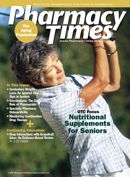Rx Product News Profile: A closer look at new FDA actions: Novartis' Valturna
The FDA has approved Valturna (aliskiren/valsartan) to treat hypertension.
Both Ms. Belisle and Ms. Patel are pharmacists at Brigham and Women’s Hospital, Boston, Massachusetts. Mr. Varma is a sixth-year PharmD candidate from Massachusetts College of Pharmacy, Boston, Massachusetts, currently on clinical clerkship in the Investigational Drug Service at Brigham and Women’s Hospital.
Novartis’ Valturna
On September 16, 2009, the FDA approved Novartis Pharmaceutical’s combination pill, Valturna (aliskiren/ valsartan), to treat blood pressure not adequately controlled with monotherapy or as initial therapy in patients likely to need multiple drugs to achieve their blood pressure goals.1 The medication may also be substituted for patients who are already taking aliskiren (Tekturna) and valsartan (Diovan).1

Pharmacology/Pharmacokinetics
Valturna is a combination product that inhibits the renin-angiotensin-aldosterone system at 2 different locations.2 Aliskiren is a direct renin inhibitor, which prevents the conversion of angiotensinogen to angiotensin I, which is the precursor to angiotensin II, a potent vasoconstrictor.3 Valsartan is a angiotensin II receptor antagonist that binds to angiotensin I receptors on tissue, preventing angiotensin II from exerting its effects, in the vascular smooth muscle and adrenal gland.3
Valturna reaches peak plasma concentrations within 1 hour for aliskiren and 3 hours for valsartan, with a mean half-life of 34 hours for aliskiren and 12 hours for valsartan.3 High-fat meals reduce the absorption of Valturna; therefore, intake of high-fat meals with Valturna should be avoided.3 Aliskiren is metabolized via CYP3A4 and valsartan is a minor substrate of CYP2C9; however, both drugs do not induce nor inhibit the CYP450 isoenzymes.3
Dosing
Valturna is available in 2 dosage strengths—(aliskiren/valsartan) 150-mg/160-mg and 300-mg/320-mg tablets.3 Therapy should be initiated at 150-mg/160 mg, titrating up as needed to the 300-mg/320-mg tablets.3 No dosage adjustments are required in the geriatric population, nor are any dosage adjustments required in patients with mild-to-moderate renal or hepatic impairment.3 Clinical experience with dosing Valturna in patients with severe hepatic or renal impairment is limited; caution should be used when treating this patient population.3
Clinical Trials
The efficacy and safety of Valturna were evaluated in an 8-week, randomized, double-blind, parallel-group, placebocontrolled trial with close to 1800 subjects enrolled in the study. The study recruited men and women aged 18 years or over with stage 1 or 2 hypertension, with the majority of patients diagnosed with stage 2 hypertension (59%).4
Patients were first entered into a 1- to 2-week washout period, where patients were not allowed to take any antihypertensive agents. Patients were then randomized to receive placebo, aliskiren 150-mg monotherapy, valsartan 160-mg monotherapy, or aliskiren/valsartan 150-mg/160-mg combination therapy. After the fourth week, patients underwent a forced titration to double the initial dose of their treatment regimen.4
At 8 weeks, subjects randomized to the Valturna group lowered their mean sitting diastolic blood pressure from baseline by 12.2 mm Hg, compared with the other 3 groups: aliskiren 300 mg, 9.0-mm Hg decrease; valsartan 320 mg, 9.7-mm Hg decrease; placebo, 4.1- mm Hg decrease (P <.0001).4 Of the patients in the Valturna group, 49% achieved blood pressure <140/90 mm Hg, compared with 37% in the aliskiren group (P = .0005) and 34% in the valsartan group (P <.0001).4
The incidence rates of adverse events between aliskiren/valsartan, valsartan, and aliskiren were similar. Common adverse effects seen with Valturna were fatigue, dizziness, diarrhea, and cough.5
Precautions/Contraindications
Valturna should be avoided in patients during pregnancy (Category D) and is not recommended in nursing mothers due to inconclusive data regarding excretion in breast milk.5
Other less common, but more severe adverse events patients can experience include angioedema and hyperkalemia; caution should be used if Valturna is given together with potassium-sparing diuretics like spironolactone, triamterene, or amiloride.3
Concomitant administration of Valturna and cyclosporine should be avoided due to a 2.5-fold increase in aliskiren concentration.3
Coadministration of aliskiren with atorvastatin or ketoconazole increased aliskiren plasma levels by 50% and 80%, respectively; caution should be used when dosing Valturna with either of these agents.3
Coadministration of aliskiren with furosemide may reduce the area under the plasma concentration-time curve and maximum concentration of furosemide by about 30% and 50%, respectively.3 â–
References
1.
FDA Web site. www.accessdata.fda.gov.
2.
Novartis Pharmaceuticals Inc’s Website. Novartis’ Valturna (Press release).
3.
Valturna [package insert]. East Hanover, NJ: Novartis Pharmaceuticals Inc; 2009.
4.
Oparil Suzanne, Yarows A Steven, Patel Samir, et al. Efficacy and safety of combined use of aliskiren and valsartan in patients with hypertension: a randomized, double-blind trial. Lancet. 2007; 370: 221-29.
5.
Valturna. In Lexi-Comp, Inc[database]. Copyright 1978-2009. Updated 10/22/09. Accessed 11/24/2009.

